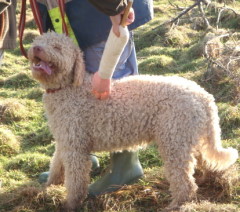|
|
DesensitisationThis is a process of exposing a dog repeatedly to stimuli that cause fear, anxiety or aggression, in sufficiently small doses so as not to cause the response. The stimuli are then gradually increased in small enough increments that do not lead to a recurrence of the response. The stimuli are repeated so many times with no effect that they become inconsequential. Desensitisation is usually used alongside counterconditioning as it is essential to change the dog's emotional response as well as to desensitise. This is one type of counterconditioning that was developed by Wolpe in 1958 to treat fears, anxieties and phobias in people (Burch & Bailey 1999). Phobias are fears that are so extreme they impair or change the way that one functions. Although there are ways to eliminate such classically conditioned responses, simply removing the conditioned stimulus is not one of them. If you have a fear of spiders, removing spiders from your environment will not remove your fear as you will only be OK as long as you see no spiders. Next time you see a spider, the fear will reappear. The same is true of dogs. A dog that is frightened of being in the ring due to a fearful experience will not lose its fear just by being given a break from showing: the fear will reappear as soon as the dog returns to the ring. When working with a dog that is fearful of a specific situation or event, reinforcers must be given for appropriate behaviours. The dog should not be overly coddled or babied as these could easily shape the dog to be more fearful as it discovers that a fear response makes the owner give it huge amounts of attention.
Once you have changed the dog's conditioned emotional response (cer) to whatever it is fearful of, then you can begin to desensitise. The process starts with the 'scary' object (dog, person, car etc.) at a distance that the dog doesn't react to (no stiffening, tensing etc.) and the dog is continually rewarded for the whole time the 'scary' object is present with the reward disappearing when the 'scary' object goes away. This should sound similar to counterconditioning. Use the same 'scary' object for the full process before repeating with a different dog, person, car etc. The next step is to bring the 'scary' object closer, perhaps by 30cm, the increments are to be determined by your dog and his/her reactions. A dog that can cope with a scary object at 100m may be able to cope with a decrease in distance of 1m or perhaps 5m, whereas one that can cope with the scary object at 1m may only cope with a change of 5cm at a time. After several repetitions at this distance, the distance can be reduced again. The next step is to again reduce the distance, repeat several times and then reduce the distance again so that eventually the scary object is quite close to your dog. This process will take several days/weeks. Once the dog is happy in the presence of this scary object, then introduce a different variant of the same thing i.e. a different person, different dog etc. and repeat the process. This time the process should go quicker. Repeat numerous times with different people (sexes, ages, races etc.), dogs (colours, breeds, ages etc.). Once your dog is happy with many different variants of the same scary object, then repeat the process in different areas; quiet area, park, shopping centre, training class, dog show etc.
|
|
